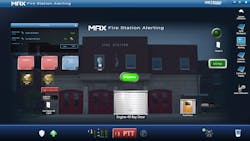Going back to the watchmen’s rattles and the clanging gong in the town square, firefighters continually sought ways to be alerted to an alarm. Although “putting the wet stuff on the red stuff” remained our strategy for decades, changes in technology allow for vast improvements in how we get our calls.
Because of this, the firehouse siren and joker tape—at one point, marvels in their own right—are giving way quickly to devices that provide critical information to volunteers regardless of their location and control numerous functions inside of the stations of career departments.
The now
Perhaps the most pervasive lifestyle changer of the past 25 years is the cellphone. Many people seem to be connected if not by the hip, then at least by the thumbs, to these ubiquitous devices. eDispatches leverages them as tools to offer alerting capabilities in addition to their conventional uses. According to a spokesperson, “In recent years, we have added [the features of] availability and response. Responders can set their availability throughout the day before calls occur, so the department can see who is or is not available. Additionally, once a call is dispatched, personnel can identify if they are going to the station, scene or not going on the call.” Real-time tracking enables the incident commander to know the number of firefighters who are available as well as their identities and proximity to the scene. Because cellphones have evolved to combine functionality that formerly was provided by a number of disparate devices—in other words, the smartphone—eDispatches touts not having to carry separate electronics for personal and fire service purposes as a comparable benefit.
John Martyn, who is senior product manager for Zetron, which produces mission-critical integrated notification hardware and software, says changes in a number of diverse components have led to improvements, and a steady stream of solutions across the ecosystem are evidence of a broad switch to all-internet protocol (IP)-based technologies. “This lends itself to greater interoperability between the emergency control center, the firehouse, the radio network and the mobile data terminals. The widespread use of IP solutions means the days of the rip ’n run printer are fading away and replaced with the latest CAD system provider capabilities that digitally push the request for assistance to the mobile device. The ever-increasing use of digital radio and even the recent expanded use of cellular notification via the multiple commercial PTT (push-to-talk) offerings means the quality and choices of transmitting the alerts is greater than ever before.”Although excited about the prospects, he offers a word of caution. “Access to increased data will make the fire service more efficient, but with modern technology turning to IP solutions, the need for cybersecurity is also increased. Traditionally, departments have not been exposed to that concern.”
Since there seemingly is no end in sight to the current shortage of telecommunicators, strategies that can improve efficiency are in high demand. Locution Systems is a purveyor of automated human voice solutions that help to reduce dispatcher workload. Using the prerecorded voices of real people, alarm assignments are broadcast in a consistent order, which helps to create standardization. Additionally, the firm manufactures scalable devices for station alerting that can notify selected zones or sleeping areas. According to Ryan Riggins, marketing specialist, there has been a significant amount of research carried out over the past couple of years regarding the negative effects of alerting methods. “Ramped tones and lights have grown in popularity significantly as a front runner of ways to improve.” He adds, “As an example, we developed our red Night Vision alerting lights to put out the exact amount of light to alert responders while ensuring night vision is not impaired, focusing all the way down to pupil contraction.”
The future
Regardless of the format that’s used for alerting, there must be a medium over which to transmit the details of the dispatch. Enter FirstNet. With more than 15,000 agencies and more than two million connections nationwide already online, the platform is well on its way to achieving the goal of coast-to-coast interoperability.
This global change in the way that we communicate obviously affects the way that we are notified of emergencies. As with any period of transition, departments will find ways to integrate legacy systems into the process while new seamless applications are developed. According to Gary McCarraher, who is FirstNet Authority’s senior public safety advisor for the fire service, “My organization is specifically looking for feedback from the fire service on how we can evolve FirstNet to meet firefighters’ needs.
“What’s important to remember is that FirstNet is an LTE [Long Term Evolution] network that provides public safety with a wide, safe and secure pipeline for voice, video and data.” He explains that FirstNet Authority actively works with industry to provide insights to manufacturers who are interested in developing applications and devices in the fire service technology space.
How will the firefighters of the future be alerted to alarms? Will it be through enhancements made to current devices or by technology not yet imagined? One thing that is clear: No matter how we receive it, we’ll be answering the call.









